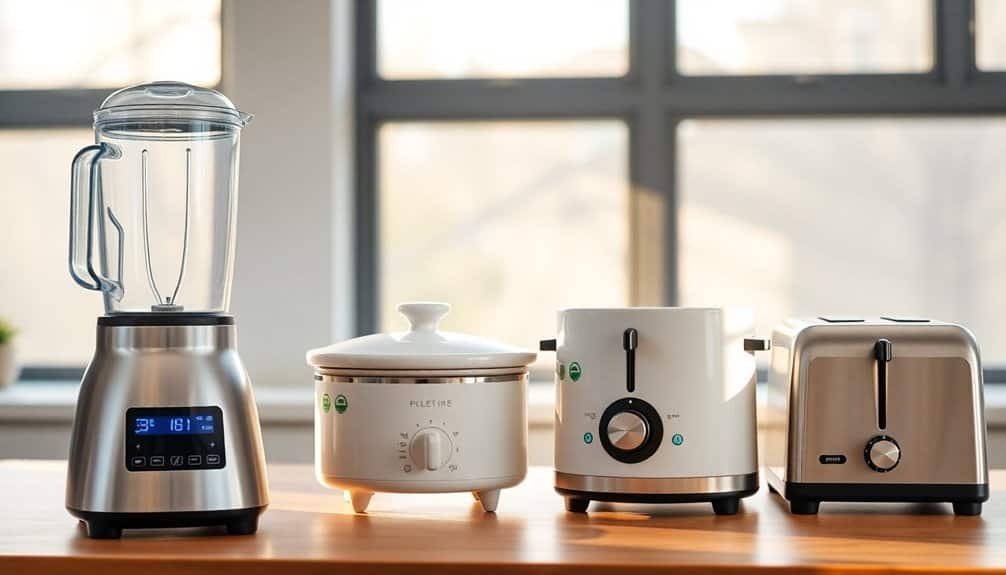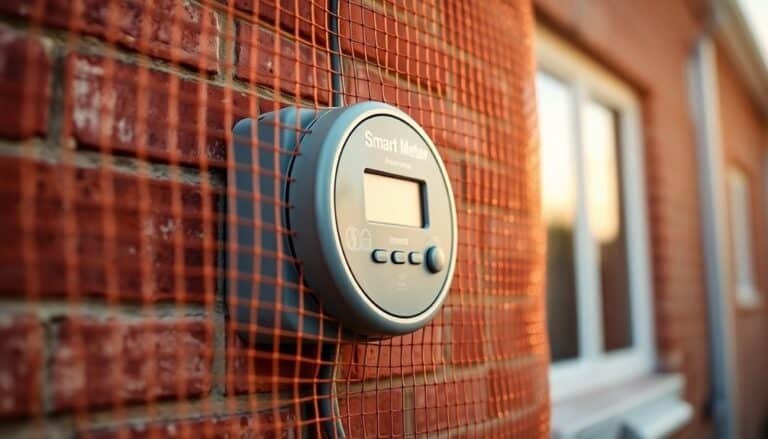Choosing Safer Appliances (Low-EMF Options)

Opt for appliances with low EMF emissions, such as electric stoves, oil-filled space heaters, and infrared heaters. Consider wired options over Wi-Fi routers, microwaves, and smart devices to reduce exposure.
Turn off devices when not in use and choose energy-efficient designs made from eco-friendly materials. As you explore, you’ll find more ways to minimize EMF in your home.
Disclaimer: As an affiliate, I may collect a share of sales from the links on this page.
Understanding EMF Emissions in Appliances

How aware are you of the electromagnetic fields (EMFs) emitted by household appliances? EMFs are areas of energy tied to electrical power use. They fall into two frequency types: extremely low frequency (ELF) and high-frequency (HF).
Common sources include appliances and wiring, with EMF strength measured in microteslas (µT). Different appliances, especially older ones, emit varying levels of EMFs based on design and power consumption. For instance, (appliances with high electrical power consumption) generate stronger fields. Air conditioners, in particular, are among the worst offenders for EMF radiation exposure, emitting high levels comparable to circuit breakers.
Understanding these emissions is essential for managing potential health concerns linked to long-term exposure. Regular assessments can help you track EMF levels in your home environment.
Identifying High-EMF Appliances
Identifying high-EMF appliances in your home can greatly reduce your exposure to electromagnetic fields. Smart home devices, including sensors and automation systems, often emit elevated levels due to wireless connectivity. Wi-Fi routers and modems continuously release EMF to maintain internet access. Other high-EMF sources include microwave ovens, which produce high-frequency emissions during operation, and cell phones, along with Bluetooth devices, which emit radiofrequency (RF) EMF. Additionally, smart meters and 5G devices contribute significantly to ambient EMF levels. Understanding these appliances helps you mitigate exposure effectively and promotes a healthier living environment. Regular inspections can help identify sources of EMF in your home and reduce unnecessary exposure. Be aware that cumulative exposure to multiple devices can increase potential health risks.
Exploring Low-EMF Alternatives

Exploring low-EMF alternatives is essential for anyone looking to reduce their exposure to electromagnetic fields without sacrificing comfort.
Electric stoves with low EMF output, space heaters like oil-filled radiators, and ceramic heaters are great options. Electric appliances emit electromagnetic radiation, so selecting those designed with lower emissions is crucial for reducing overall exposure. Panel space heaters utilize convection technology, producing ultra-low EMF emissions. Infrared heaters also provide a safer heating method. Additionally, opting for low EMF hair dryers can significantly minimize radiation exposure during daily routine.
Many low-EMF appliances consume less energy, enhancing sustainability while offering safety features like unexposed heating elements. When buying, consider research on low EMF ratings, consumer reviews, and certifications. With increased consumer demand, low-EMF options are expanding, ensuring more choices for health-conscious households.
Tips for Reducing EMF Exposure
Reducing EMF exposure can greatly enhance your daily environment, especially if you incorporate a few strategic changes.
Start by turning off devices when not in use; unplugging minimizes both energy consumption and EMF exposure.
Create EMF-free zones, particularly in bedrooms, by removing electronics.
Optimize device placement by keeping routers and appliances away from frequently used areas.
Consider wired connections instead of wireless to lower exposure.
Regularly inspect appliances for proper functioning, as well-maintained devices emit less EMF.
Finally, choose low-EMF products and limit the duration of use for high-emission devices, ensuring a safer living space.
The Role of Distance in EMF Safety

Understanding the relationship between distance and electromagnetic field (EMF) exposure is essential for ensuring safety in your environment. EMFs notably decrease as you move away from their source.
For instance, to reduce exposure near high-voltage lines to 0.5 milligauss (mG), you should maintain a distance of at least 700 feet. Household appliances can also pose risks, and increasing your distance can be beneficial.
Individuals with EMF hypersensitivity may need to extend this distance up to a half mile. Using gaussmeters to measure magnetic fields helps identify appropriate safe distances, ensuring you minimize risk while maintaining a comfortable living space.
Choosing Energy-Efficient and EMF-Reducing Products
When selecting appliances, balancing energy efficiency with low EMF emissions is increasingly important.
You can make informed choices by considering the following factors:
- Appliance Design: Research models that prioritize both energy efficiency and reduced EMF emissions, as some designs favor one over the other.
- Measurement Tools: Utilize EMF measurement tools to verify the emissions of appliances, ensuring you choose lower-EMF options.
- Older Models: Consider older appliances with fewer electronic components; they often emit less EMF compared to newer, energy-efficient alternatives using variable-speed motors.
These strategies help you minimize EMF exposure while enjoying energy savings.
Future Trends in Appliance Design and EMF Reduction
As appliances evolve, designers prioritize both functionality and user well-being while integrating advanced technology.
Smart integration allows devices to connect seamlessly, enhancing user control and automation through IoT technology.
Future trends emphasize energy-efficient designs, using eco-friendly materials that minimize waste and lower environmental impact.
AI technology adapts appliances to your habits, optimizing performance.
You can expect appliances with low EMF designs and EMF-resistant materials, offering healthier options.
Features like built-in water filtration and steam cooking enhance usability.
Minimalist, timeless designs simplify interactions, ensuring intuitive control, while real-time performance feedback keeps you informed about efficiency and safety.
Frequently Asked Questions
How Can I Measure EMF Levels in My Home?
To measure EMF levels in your home, use a certified EMF meter. Position it about one meter above ground in various locations, like bedrooms and workspaces, and take readings at different times for accuracy.
Are There Specific Brands Known for Low-Emf Appliances?
Isn’t it reassuring to know some brands prioritize your health? Amana, Frigidaire, and Whirlpool offer simpler, low-EMF appliances. By choosing these, you’re taking proactive steps to reduce your exposure while still enjoying reliable performance.
What Common Household Items Emit EMFS Besides Appliances?
You’ll find that many everyday items emit EMFs, including cellphones, laptops, gaming consoles, smart home devices, and even household wiring. Understanding these sources helps you minimize your exposure and make informed choices.
Can EMF Exposure Affect Pets or Children Differently?
Imagine your child playing beside your pet, both unknowingly affected by EMFs. You’ll find pets and children react differently, with sensitivity varying. Children face potential long-term health issues while pets endure behavioral and physical changes.
Are There Any Apps to Monitor EMF Exposure Levels?
Yes, there are several apps available that let you monitor EMF exposure levels. You can track various sources, receive alerts for high readings, and even access detailed statistics to better understand your environment.
Conclusion
Choosing low-EMF appliances is crucial for minimizing electromagnetic field exposure at home. Studies indicate that selecting lower-emission appliances can reduce exposure by up to 90%, significantly impacting health.
Understanding EMF emissions and identifying high-EMF products help in making informed choices. Opting for energy-efficient alternatives creates a safer living environment with enhanced energy efficiency and functionality.






